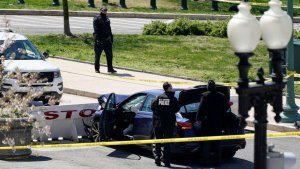Thoughts on the Capitol attack
April 7, 2021

On Friday, April 2, 25-year-old Noah Green attacked two officers at the United States Capitol Building in Washington, D.C.
Green rammed his car into a barricade at the Capitol, killing one officer and injuring another.
Green murdered one Capitol officer on impact from the collision and injured the other officer by stabbing him with a knife.
Green was shot by police and eventually died at the hospital.
The officer that died in this tragedy was William Evans, an 18-year veteran.
This turmoil occurs just under three months after the insurrection that occurred on January 6 based on conspiracy theories
about “voter fraud.”
Why is violence against our government, capitol police and public officials rising?
Lexi Langendorf, UW Oshkosh junior, had an excellent answer to this question.
“I think there has been an increase in violence against our government and police officials because it has become so normalized,” she said. “In today’s age, when people disagree with something, they turn to violent language or behaviors, when in a perfect world, we should all accept one another for who we are and what we believe in.”
Langendorf is correct; it seems that people have lost all social ability, so they express their emotion with violence.
An influencer of antisocial tendencies is the overwhelming use of technology in our society.
People do not know how to manage their emotions and they lack social skills and mannerisms because they exclusively use social media and other types of technology to express themselves, especially in a global pandemic.
I also spoke to Gaby Newman, a senior at UWO.
Newman answered the same question that I asked Langendorf.
“One of the most telling factors is the public’s tendency to consume the news, react and move on,” she said. “So many things have happened in recent memory that are talked about for a minute and then people move on. I think if more people were to have stood in solidarity against the rhetoric that fueled the insurrection at the Capitol in January, then maybe events like this wouldn’t have happened or continue to happen.”
Newman highlights something that I think we have all been guilty of, especially within the past year.
Traumatic events are forgotten easily because there are always other disturbing events to focus on.
Newman suggests that we should recognize when these chaotic events happen, such as the insurrection that occurred at the Capitol and take corrective action.
As a nation, the United States has grown increasingly divided. It is our duty to work together to ensure that America possesses some amount of peace and unity.
I also asked Newman if she could think of a way that lawmakers and citizens could unite to decrease violence against our government.
“I think lawmakers and citizens can come together to advocate for things like police reform, social justice, funding to provide mental health resources to communities and the organization of peaceful resistance movements that address the major barriers that exist within our society,” she said.
I appreciated that Newman touched on the theme of mental illness, as Green was mentally ill and this could’ve been a reason, but certainly not an excuse for his actions.
Green reportedly had delusional thoughts, claiming that he was under government control and that someone was watching him.
It has not been determined if his mental illness played a role in this attack or not.
I think Newman touches on some of the major problems that the United States has had to battle with in the past year, such as policing and social justice.
Often, I think we get so wrapped up with our own lives that we do not think about our communities and how we can help to improve the lives of others.
Green was a follower of Louis Farrakhan, who was known for his acts of antisemitism and homophobia.
Should people that take inspiration from these individuals be monitored more closely on social media?
Some of Green’s posts were centered around his inner struggles and battles with difficult situations.
I wanted to know what students at our campus thought about the increase of social media monitoring, to decrease the frequency of these catastrophes.
“I don’t know that monitoring the suspect’s social media would have helped give any warning in this scenario,” Langendorf said. “As far as I’m aware, he proclaimed his faith to be Islam and said he was having a rough time in his life, but never threatened violence.”
She thinks that since there is no evidence that Green threatened violence, his social media posts and interests don’t have a strong correlation with the attack.
Does social media present other indicators that someone is mentally unstable?
There is a common correlation of these types of disasters and the suspect’s activity on social media.
It seems that more often than not, authorities are not aware of potentially dangerous actions that are portrayed on social media.
The common subject in Newman and Langendorf’s responses is unity and finding a way to have compassion and empathy for one another.
This is something that we can all work on to create a community of inclusivity and acceptance.













